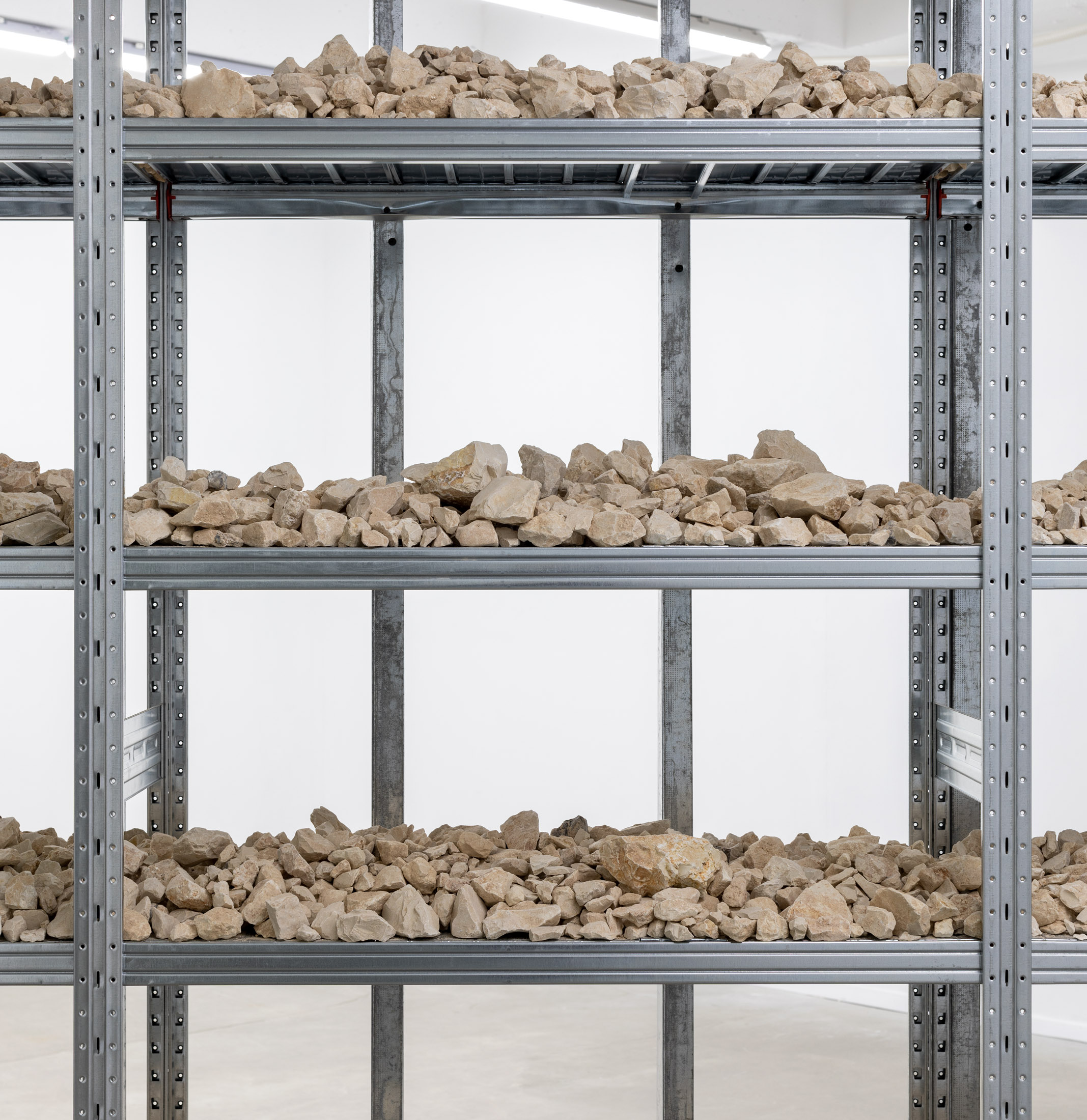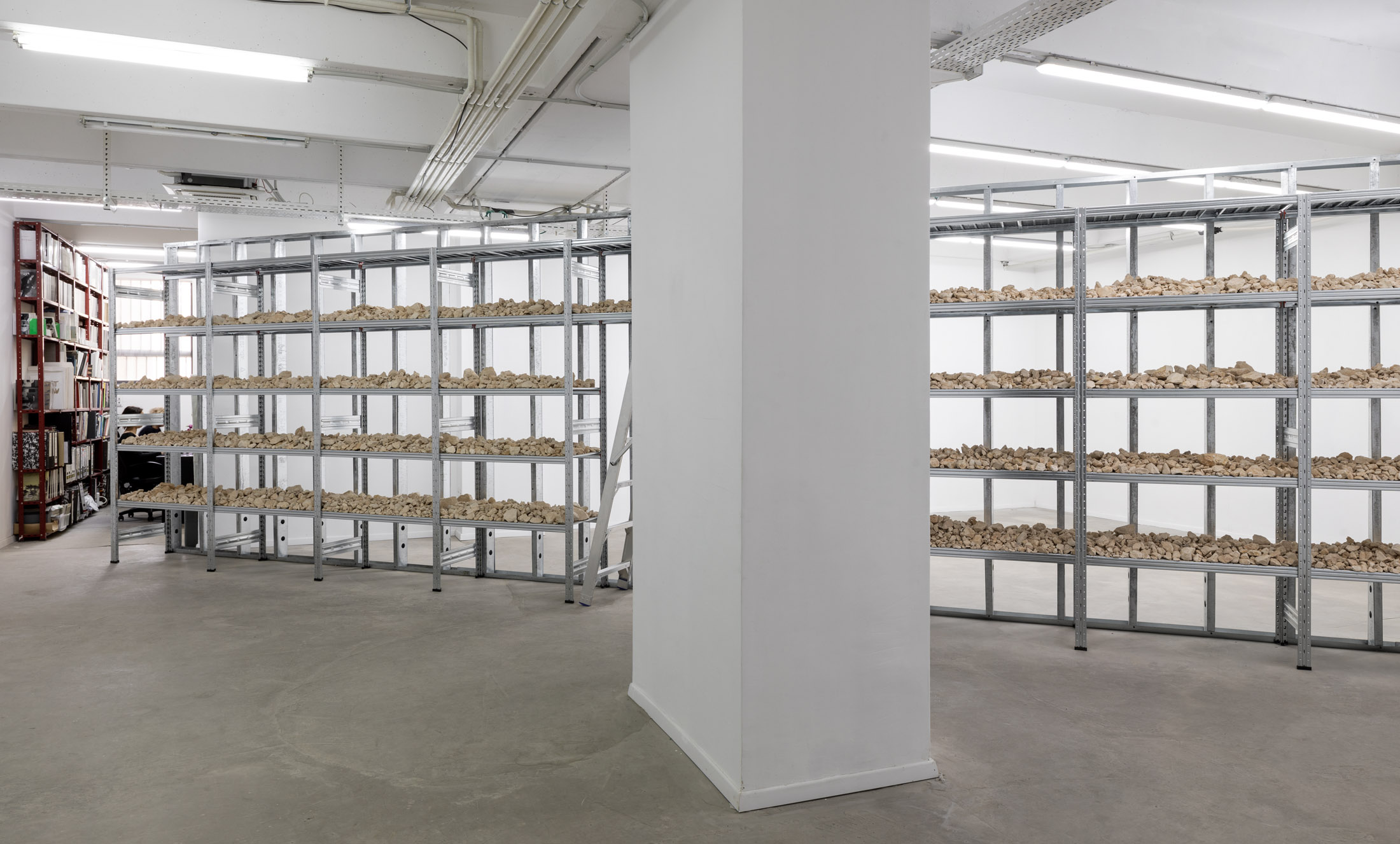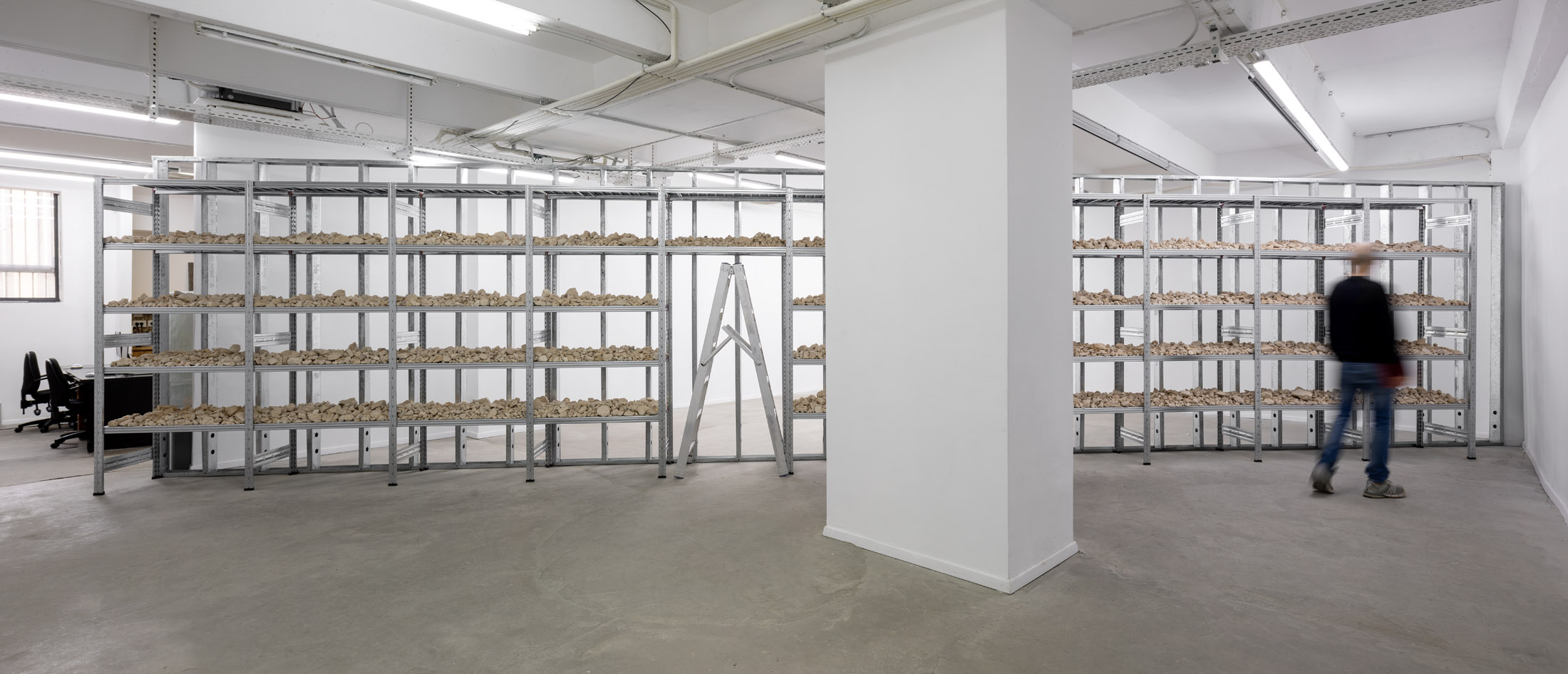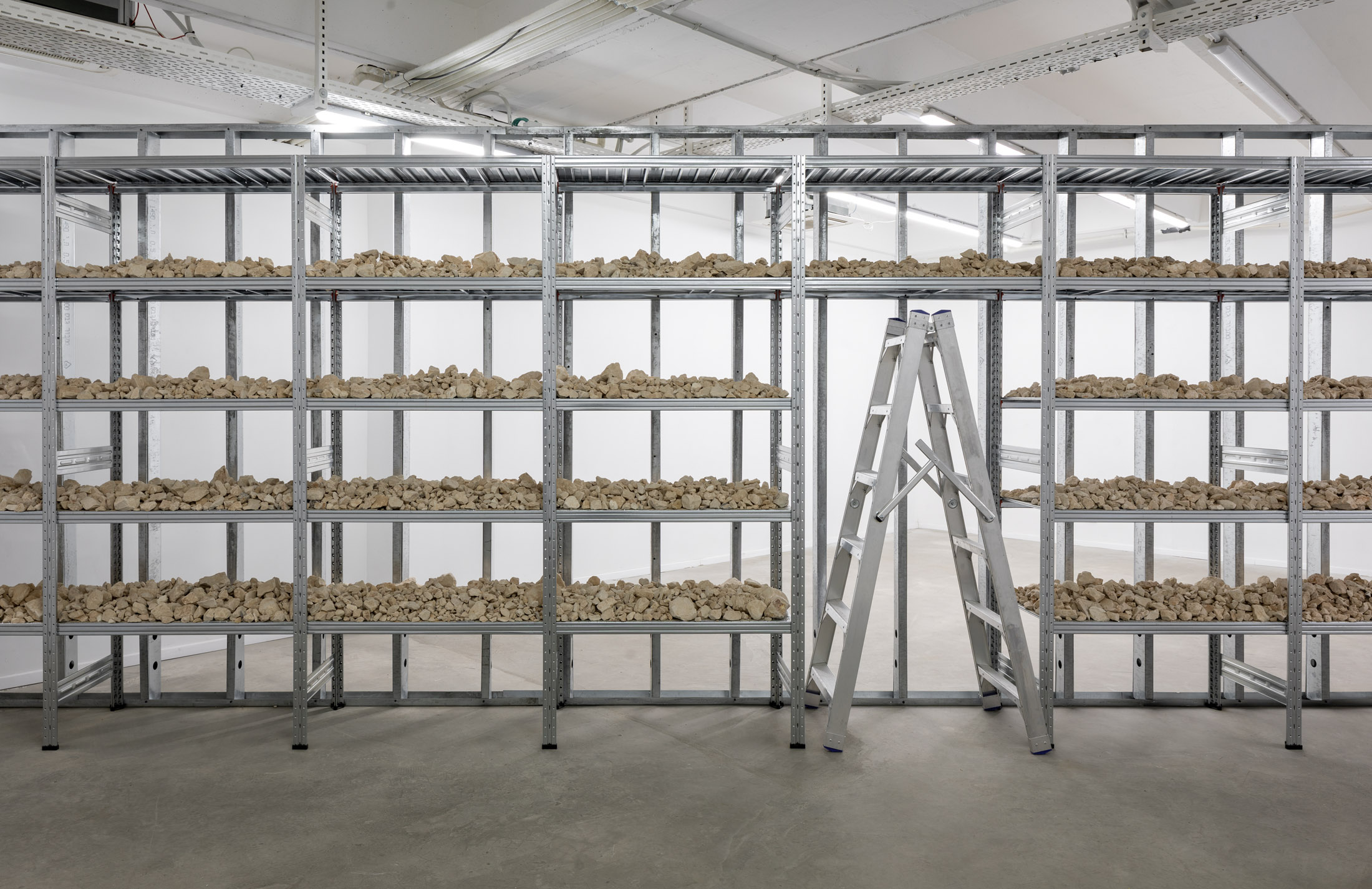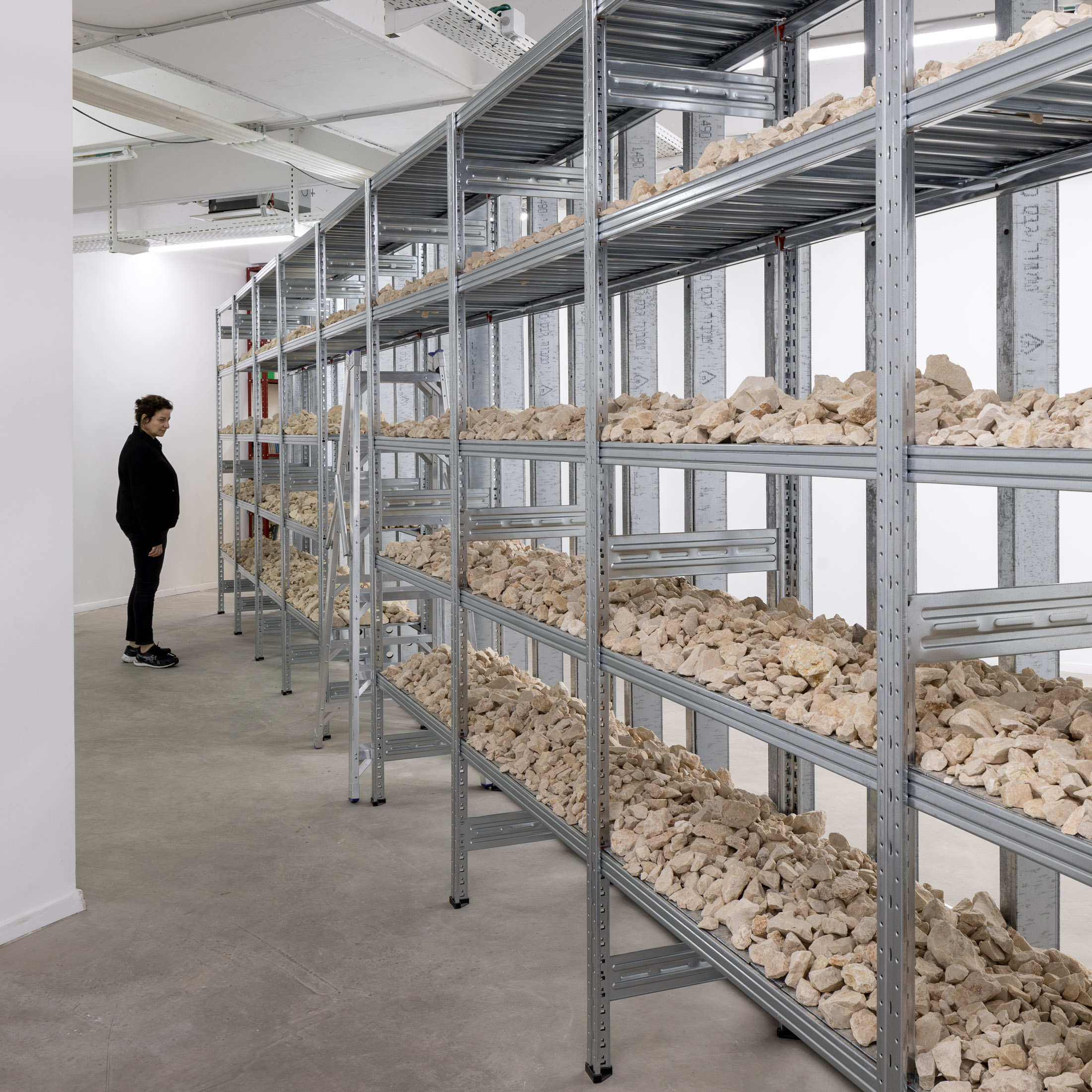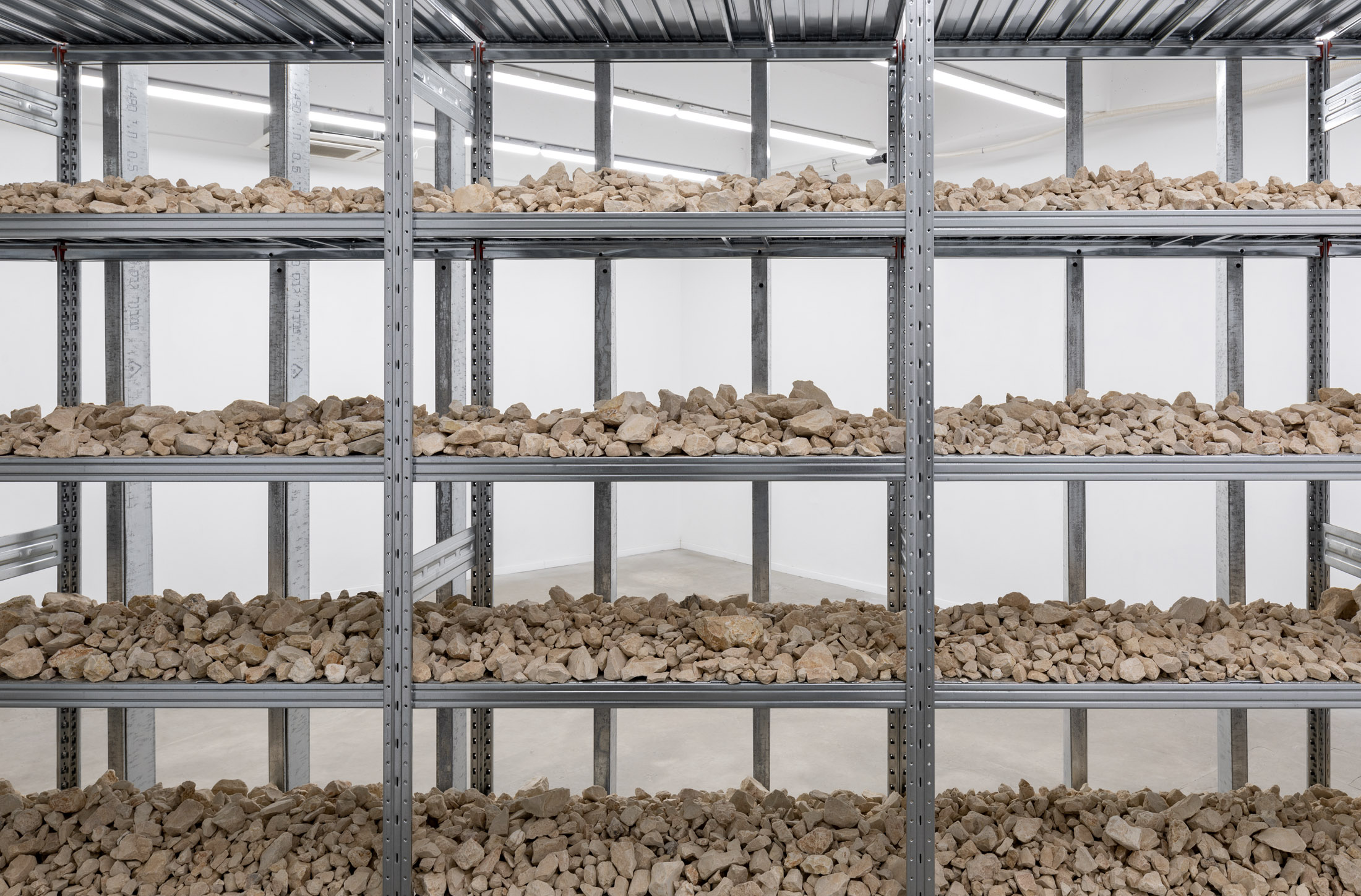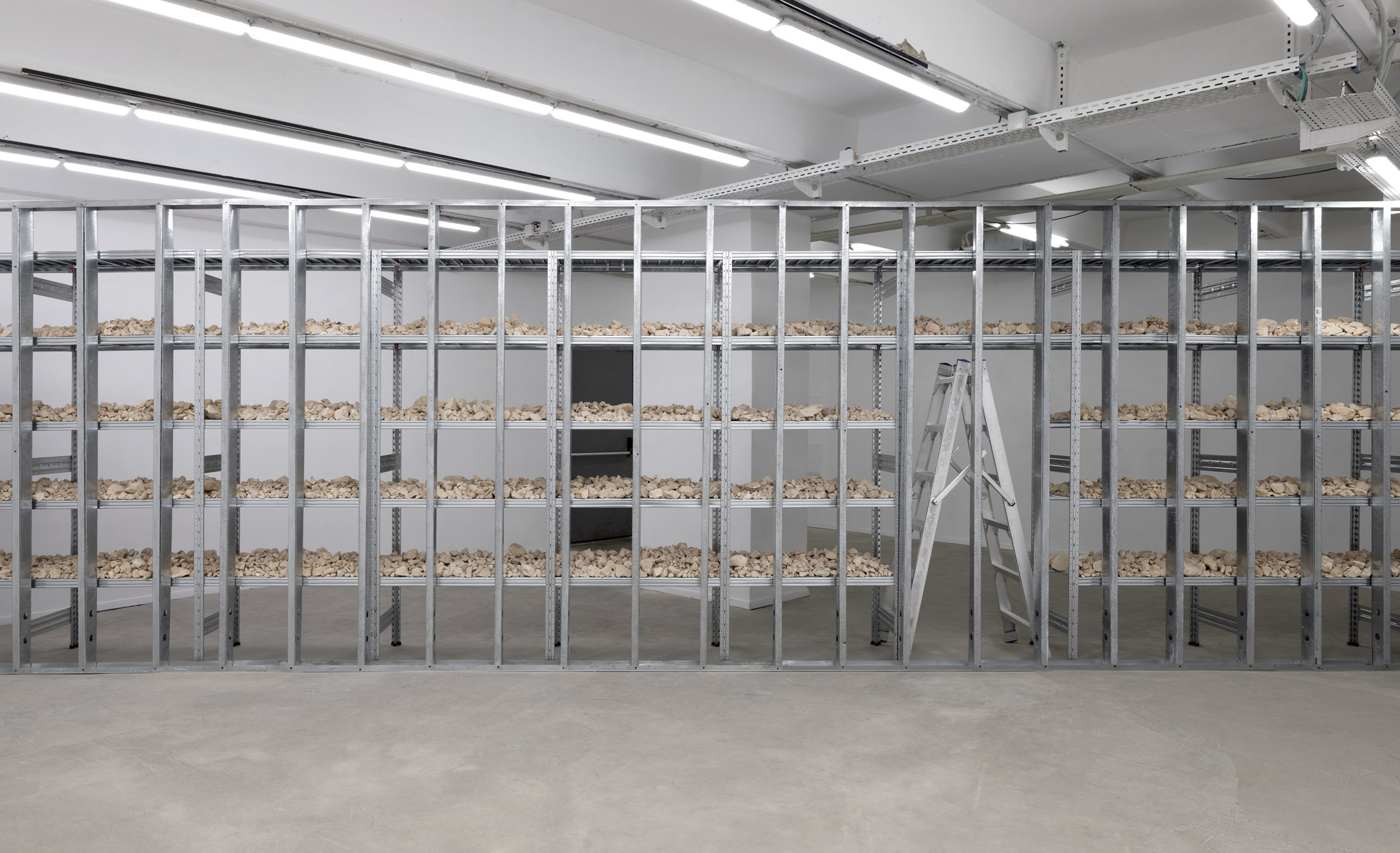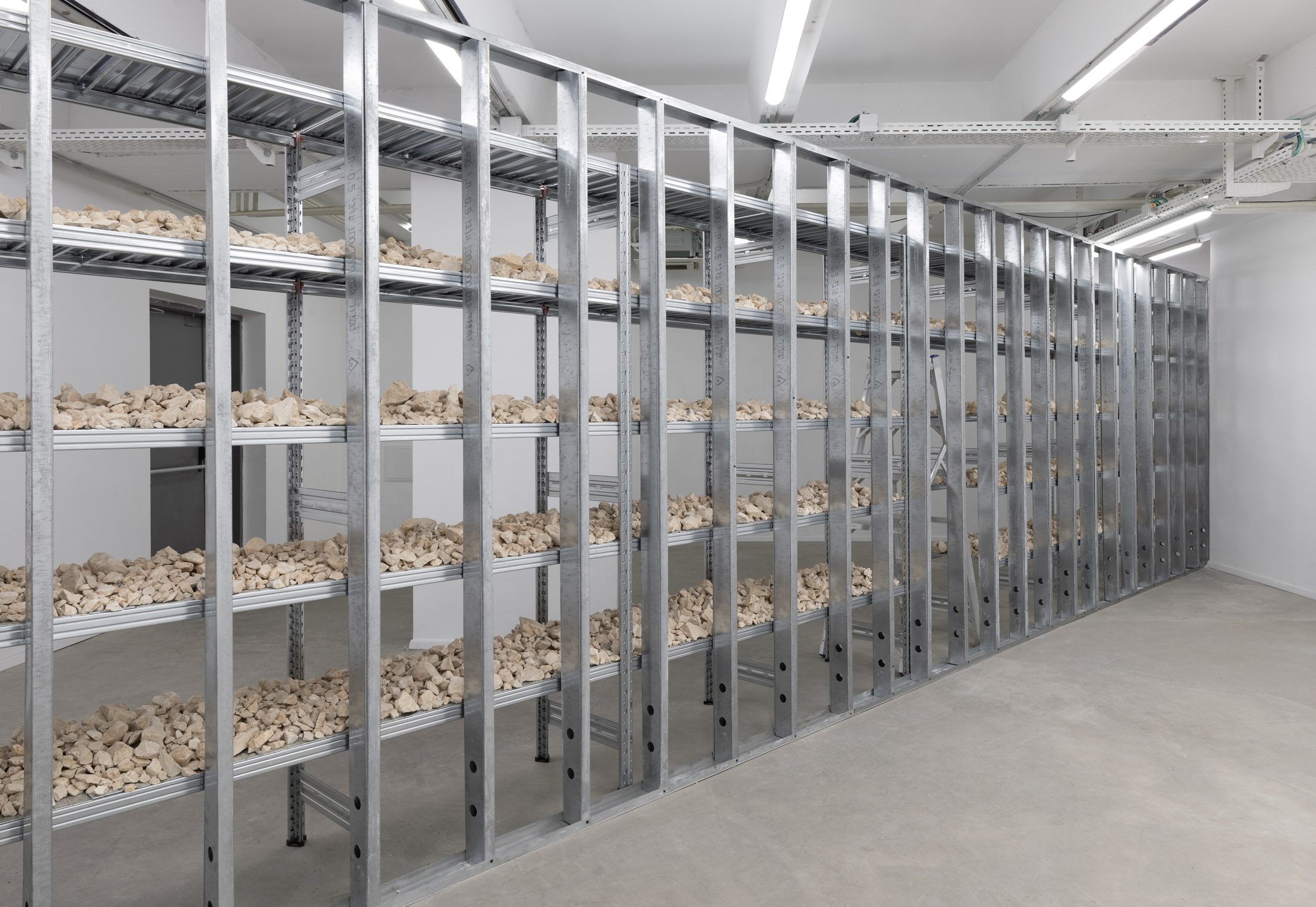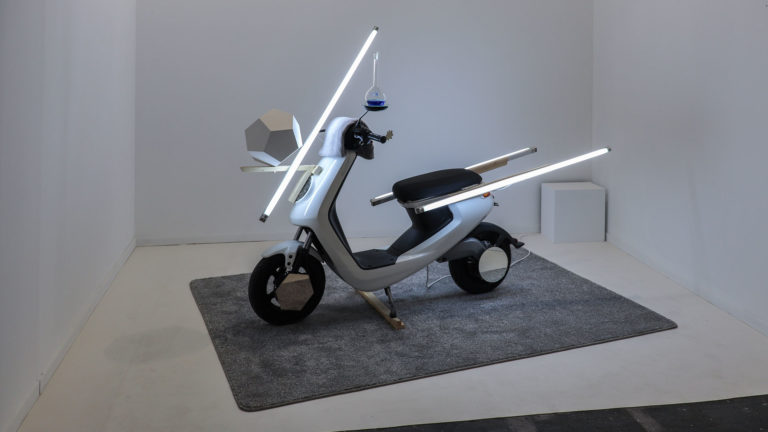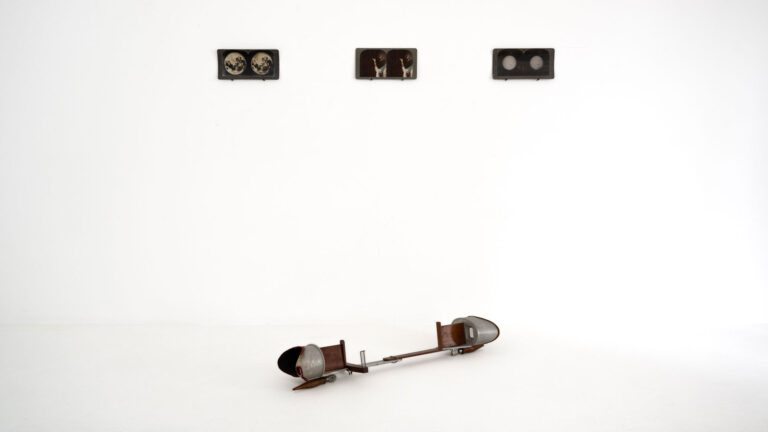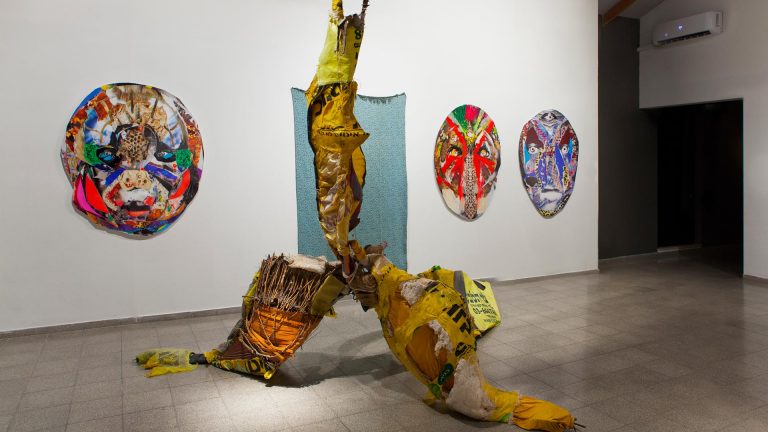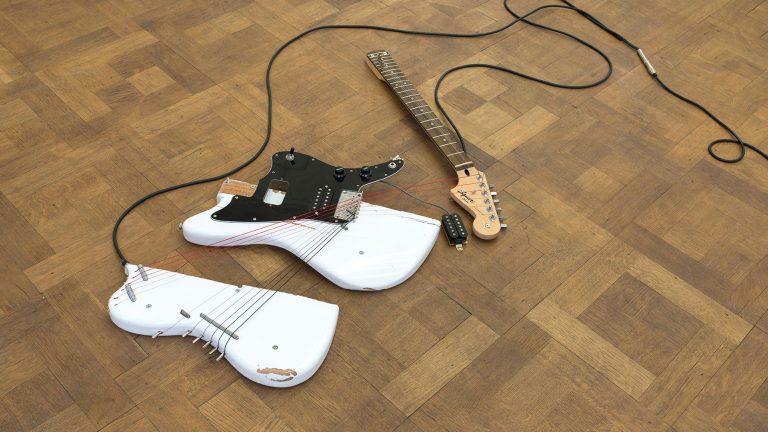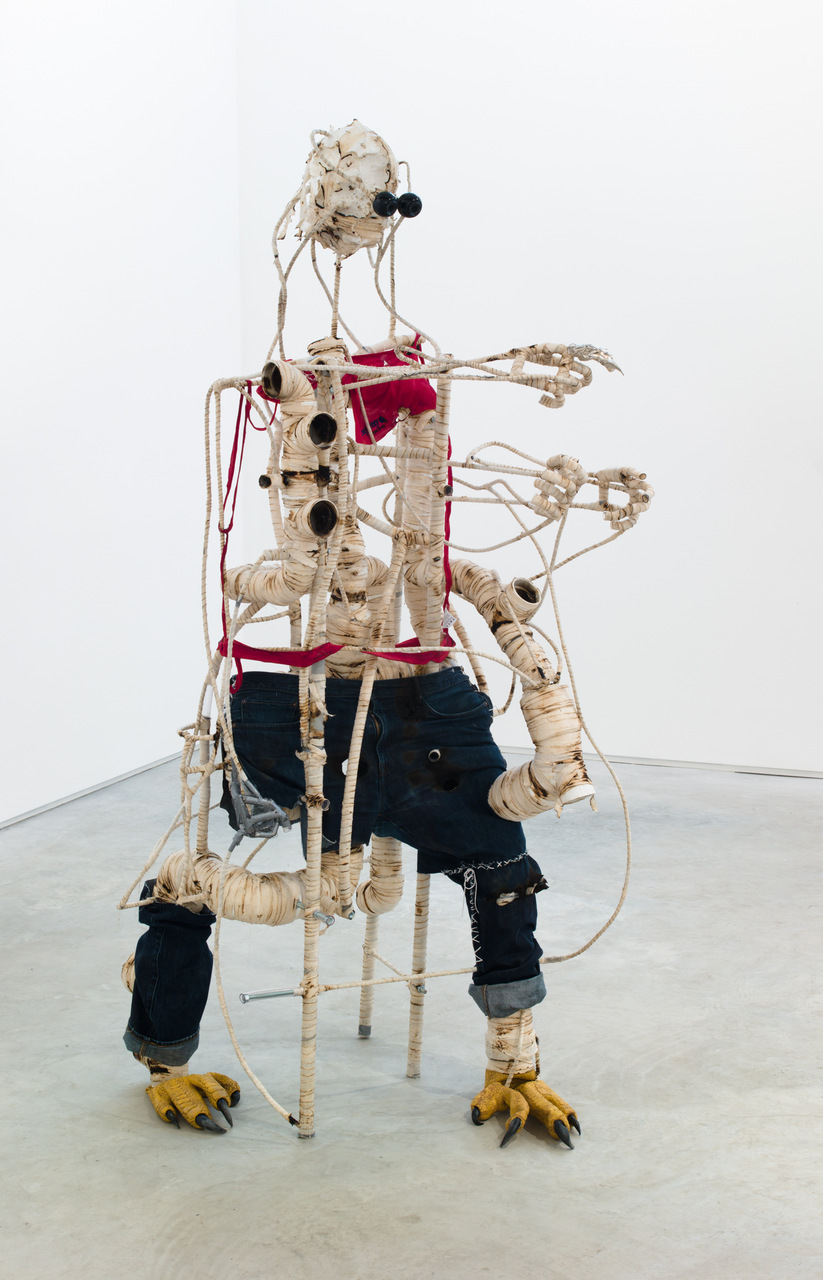Artist: Haim Steinbach
Exhibition title: Jacob’s ladder
Venue: Dvir Gallery, Tel Aviv, Israel
Date: March 16 – April 22, 2023
Photography: Elad Sarig / all images copyright and courtesy of the artist and Dvir Gallery
Haim Steinbach’s Jacob’s ladder, 1997, an installation of an aluminum ladder encompassed by industrial shelving abutting a metal stud wall, not only obstructs the visitors’ path by dividing the gallery on the diagonal, but also inverts and transposes interior and exterior. True to Steinbach’s work, the boundaries between the presentation and what is being presented are extended further than the limits of the display devices.
Jacob’s ladder was initially conceived in 1997 for his exhibition at the Museum Moderner Kunst Stiftung Ludwig Wien (MUMOK). It followed Untitled (railroad track, passenger car), 1995, a concept that was manifested in the form of a model train placed in the landscape of Mitzpe Ramon, Israel. The original intention was to construct a 100-meter long railroad track with a full-size passenger car. As a testament of the work, Steinbach produced a photograph of the model. In the photograpgh, the model train is no longer merely a model train; things appear as themselves but are intrinsically opaque, mysterious. In Jacob’s ladder, the train and the landscape merge in a layer of railway gravel spread across the grid of metal shelving. The horizon collapses into a shelf and all objects––geological, allegorical, historical––are equally considered.
Since the 1970s, Steinbach’s work reflecting on the deadlocks of Minimalism and abstract painting, as well as their perceptual limits, was shifting hierarchies between objects and subjects, figure and ground, display mechanisms and artwork. Shelves were an emblematic device for this purpose. They were elaborated over the last four decades into chromatic and geometrical elements, often made of plywood and covered with plastic laminates. Part furniture, part sculpture, these eminent pieces are carefully measured for each specific display of objects they support, which could be almost anything in the world: toys, artworks, household items, decorations, ethnographic artefacts, souvenirs, or rocks. The shelf, as a threshold, transforms the arranged objects. It exposes any object removed out of its immediate context to its own nature; singular and ordinary, common and refined, comprehensible and yet wholly obscure.
The ladder in the biblical story of Jacob’s dream serves as a gateway, a stairway to heaven upon which angels travel back and forth. God, at the top, promises Jacob and his descendants the land. Jacob marks the spot with a stone, a monument to which he shall return. The shelves in Jacob’s ladder form a grid of horizontal and vertical lines, a rhythmic composition, encompassing the installation’s aluminum ladder: a tower of sorts, or an improvised pyramid. Yet possible ascension and descension upon the ladder is obstructed by the enclosing shelves. The vertical movement of the dream is cut off, the exposed metal studs, too, recall a grating, a border fence, or prison bars.
While the first version of Jacob’s ladder in Vienna consisted of railroad gravel, at Dvir Gallery in Tel Aviv, the gravel spread across the metal shelves is native to Israel-proper, a distinction pointing to a probable leak of the “site” into the “non-site” framed within a dialectic borrowed from Robert Smithson. In his terms, a site is the “physical, raw reality”, a volcano for example, while the non-site is aimed to show the site without resembling it––a collected ton of lava sent back to the gallery. It is a “back-and-forth-thing,” Smithson said.1 Such rocks as the gravel spread in Jacob’s ladder are locally familiar in their calcite appearance and are common in nature and in gardening. They also bring to mind stones placed on graves, a Jewish custom that proposes a way of communicating with the dead by giving them a sign they have been visited. Are rocks trouble? A stone can certainly kill. Jacob’s ladder is inevitably charged with a tension between the imaginary or the phantasmatic and that which is at hand—between the gravel’s existence as a crushed rock and its being as image (a landscape, for example), between its existence as a religiously or poetically charged figure, a projection or a belief. Not long after waking up from his dream, Jacob will receive his new name: Israel.
-Tal Sterngast
Haim Steinbach, Jacob’s ladder, 1997-2023, galvanized steel and aluminum shelving; galvanized steel studs; aluminum ladder; stones variable dimensions, unique in a variation of 3, installation view, Dvir Gallery Tel Aviv
Haim Steinbach, Jacob’s ladder, 1997-2023, galvanized steel and aluminum shelving; galvanized steel studs; aluminum ladder; stones variable dimensions, unique in a variation of 3, installation view, Dvir Gallery Tel Aviv
Haim Steinbach, Jacob’s ladder, 1997-2023, galvanized steel and aluminum shelving; galvanized steel studs; aluminum ladder; stones variable dimensions, unique in a variation of 3, installation view, Dvir Gallery Tel Aviv
Haim Steinbach, Jacob’s ladder, 1997-2023, galvanized steel and aluminum shelving; galvanized steel studs; aluminum ladder; stones variable dimensions, unique in a variation of 3, installation view, Dvir Gallery Tel Aviv
Haim Steinbach, Jacob’s ladder, 1997-2023, galvanized steel and aluminum shelving; galvanized steel studs; aluminum ladder; stones variable dimensions, unique in a variation of 3, installation view, Dvir Gallery Tel Aviv
Haim Steinbach, Jacob’s ladder, 1997-2023, galvanized steel and aluminum shelving; galvanized steel studs; aluminum ladder; stones variable dimensions, unique in a variation of 3, installation view, Dvir Gallery Tel Aviv
Haim Steinbach, Jacob’s ladder, 1997-2023, galvanized steel and aluminum shelving; galvanized steel studs; aluminum ladder; stones variable dimensions, unique in a variation of 3, installation view, Dvir Gallery Tel Aviv
Haim Steinbach, Jacob’s ladder, 1997-2023, galvanized steel and aluminum shelving; galvanized steel studs; aluminum ladder; stones variable dimensions, unique in a variation of 3, installation view, Dvir Gallery Tel Aviv
Haim Steinbach, Jacob’s ladder, 1997-2023, galvanized steel and aluminum shelving; galvanized steel studs; aluminum ladder; stones variable dimensions, unique in a variation of 3, installation view, Dvir Gallery Tel Aviv

